TL;DR
Minimalism is a journey that can make life about living more by having less, and making it sustainable for everyone. Thanks to Leo Babauta for starting me on the path.
Minimalism as a concept has intrigued me for a long time. I bought a book, but did not read it. Then I watched a video on Netflix, and it was nice, but the concepts did not stick in my mind for long. Then I came across a book by Leo Babauta - The Simple Guide to Minimalist Life. I had read his blog before and found his writing interesting. Hence, I decided this was an opportunity for me to wet my toes into this world.
I read through the book, and there were several ideas and tips that I loved. So what is the next step. Writing about it is a good way for me to internalize some key ideas in it. Practising some of these ideas and sharing my experience with others, and getting thoughts and feedback would make things better. So here we are.
This is not a review of the book - I am not a reviewer at any level. This is just a post written to learn and appreciate some aspects of the book which appealed to me and some of the learning I got when trying to follow some of these ideas.
The Mental Picture
A minimalist instead embraces the beauty of less, the aesthetic of sparseness, a life of contentedness in what we need and what makes us truly happy.
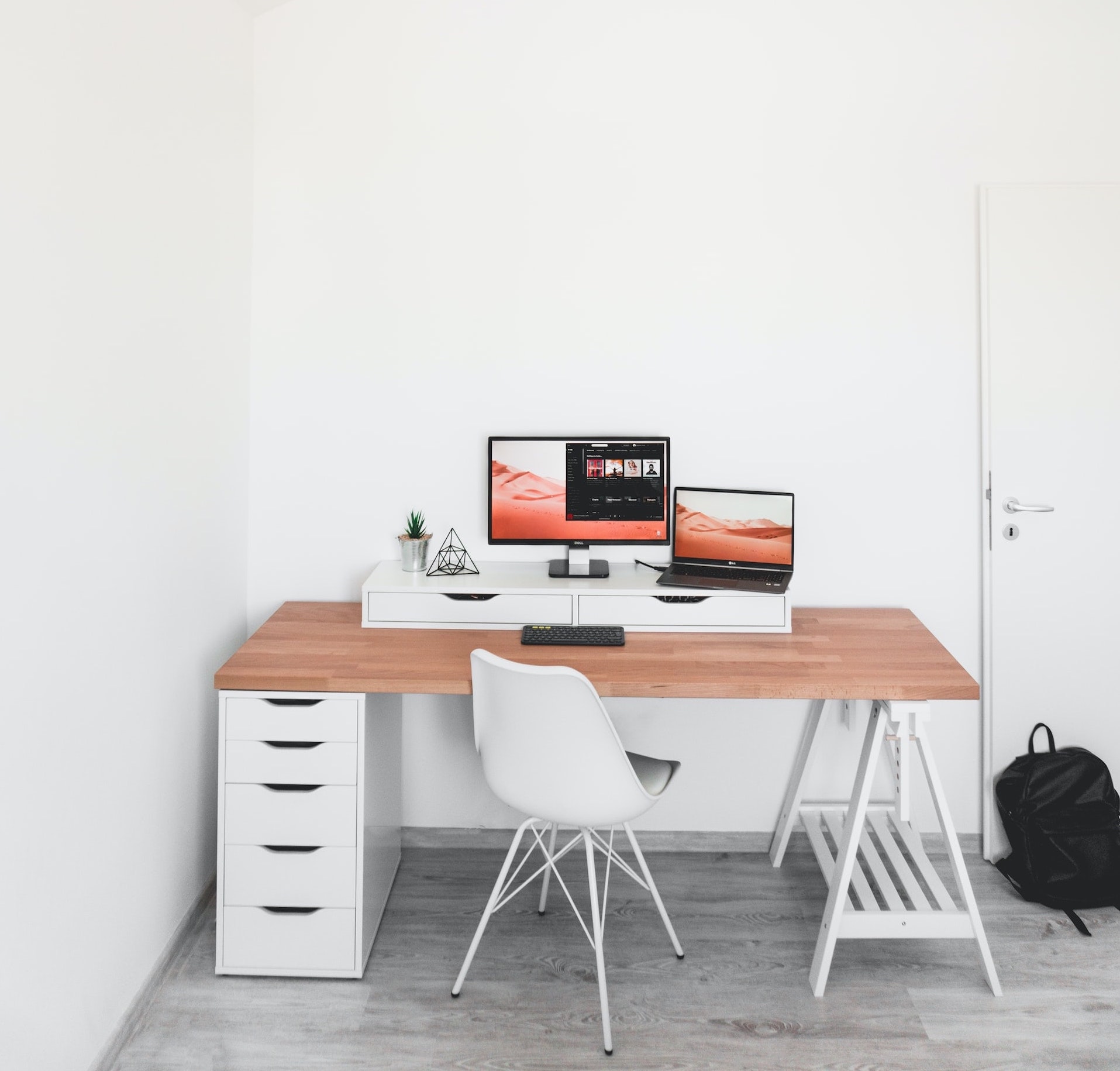
Minimalist room: Photo by Alexandru Acea on Unsplash
That quote describes a person I would aspire to be. It appeals to the romantic part of my mind. The line also makes me introspect. What makes me truly happy? It is a hard question to answer but a good one to reflect on. There is a lot of work to do, but I have gotten started. 👇
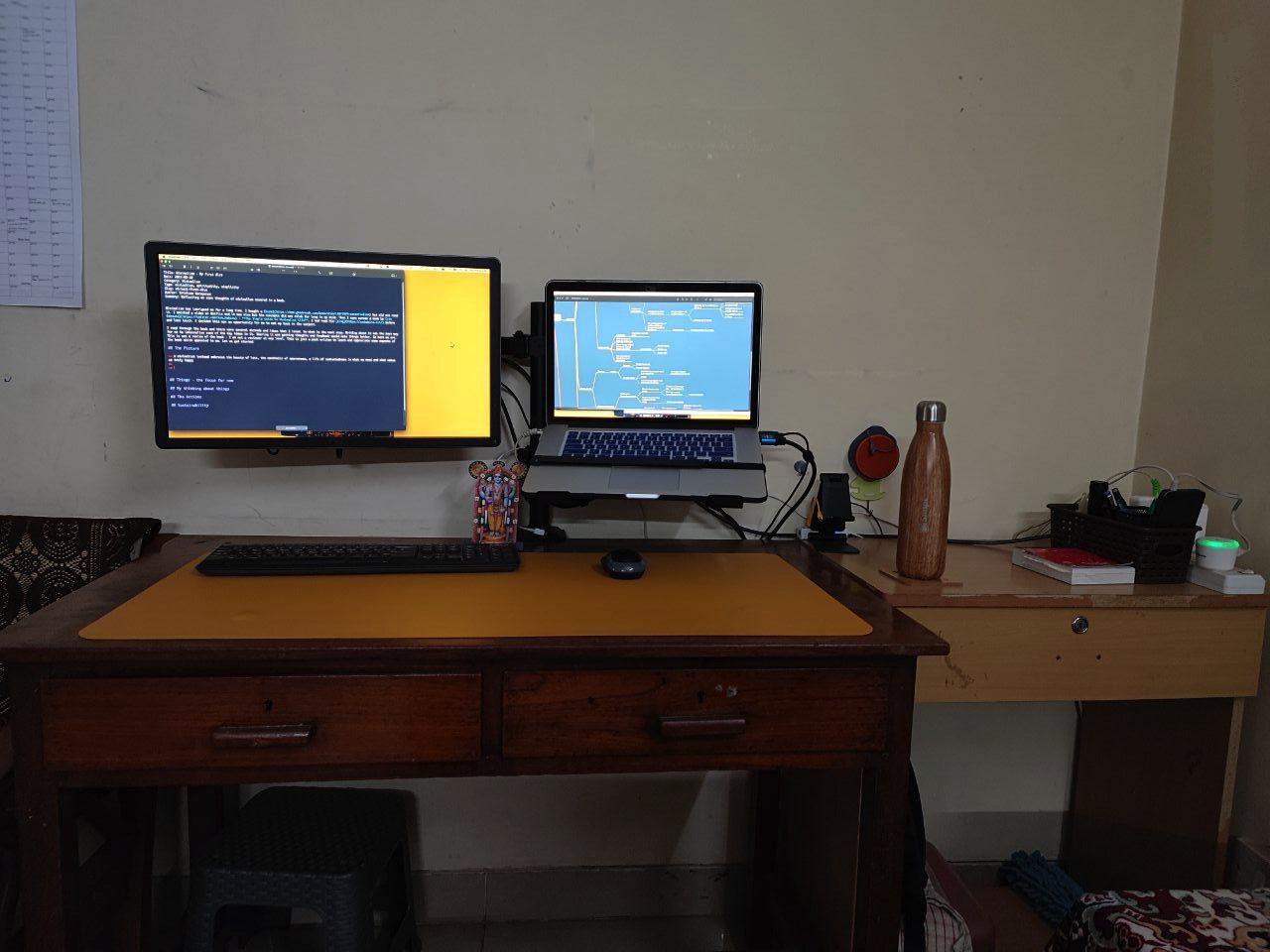
My current work desk at home- I hope that is not too bad - except the wires!
Things I own - my focus for now
Leo covers a couple of aspects of minimalism in the book. One is about the things you own, and the other is about what you do. In this post, I am focusing on the "owning things" area. I will probably cover the other big piece in a different post.
Things I own - Right Thinking & My Problems
The key idea to think and internalize in this space is Contentment.
I have enough!
Actualizing this idea is tougher than it looks. Let me talk about myself. I am pretty contented with what I have for the most part. I have a house to live in (though I live elsewhere); have a small car which I drive with my family. There is a reasonable amount of furniture, and I am not aspiring for anything fancy. I think I live well. There are small items which could be added (couple of good chairs wouldn't go amiss), but it is not urgent. But there are gray areas where I falter, and I will discuss them down the line.
One related idea which Leo talks here is the ability to differentiate between needs vs. wants. I confuse the two, not because I can't identify the difference, but because there is some greed in me, which pops out when I am not cognizant of it. For practicing contentment, this ability to differentiate needs from wants needs to be high at all times. That does not happen, and I get carried away and make mistakes. Especially in those gray areas. Let us get to them.
There are two areas where I am very bad at following the rule of contentment . One is books. Whenever I come across a book, I have the itch to own the book. I don't literally mean every book, but any book which is even remotely interesting piques my interest. It starts with the thought that I would like to read them. Now, I cannot read them all because there is only so much time, so I decide to buy them for reading later. To sum it up, I hoard books.
The other gray area is gadgets & their accessories. I buy gadgets because I like them. But that is not all. I buy them because I want a backup in case things break. My fear of things breaking is my excuse for buying more. You would say that "I could live without it for sometime till I get a replacement", and you would be right. But my stupid mind thinks differently.
The other problematic thought is about not wanting to spend a lot of money on these and ending up buying multiple cheap gadgets. This leads to clutter. Leo mentions that "A minimalist values quality, not quantity, in all forms". So my cheap gadget mentality does not help here. I am trying to change this, but it will take time. There is a whole other rant on quality which I want to get into, but now is not the time.
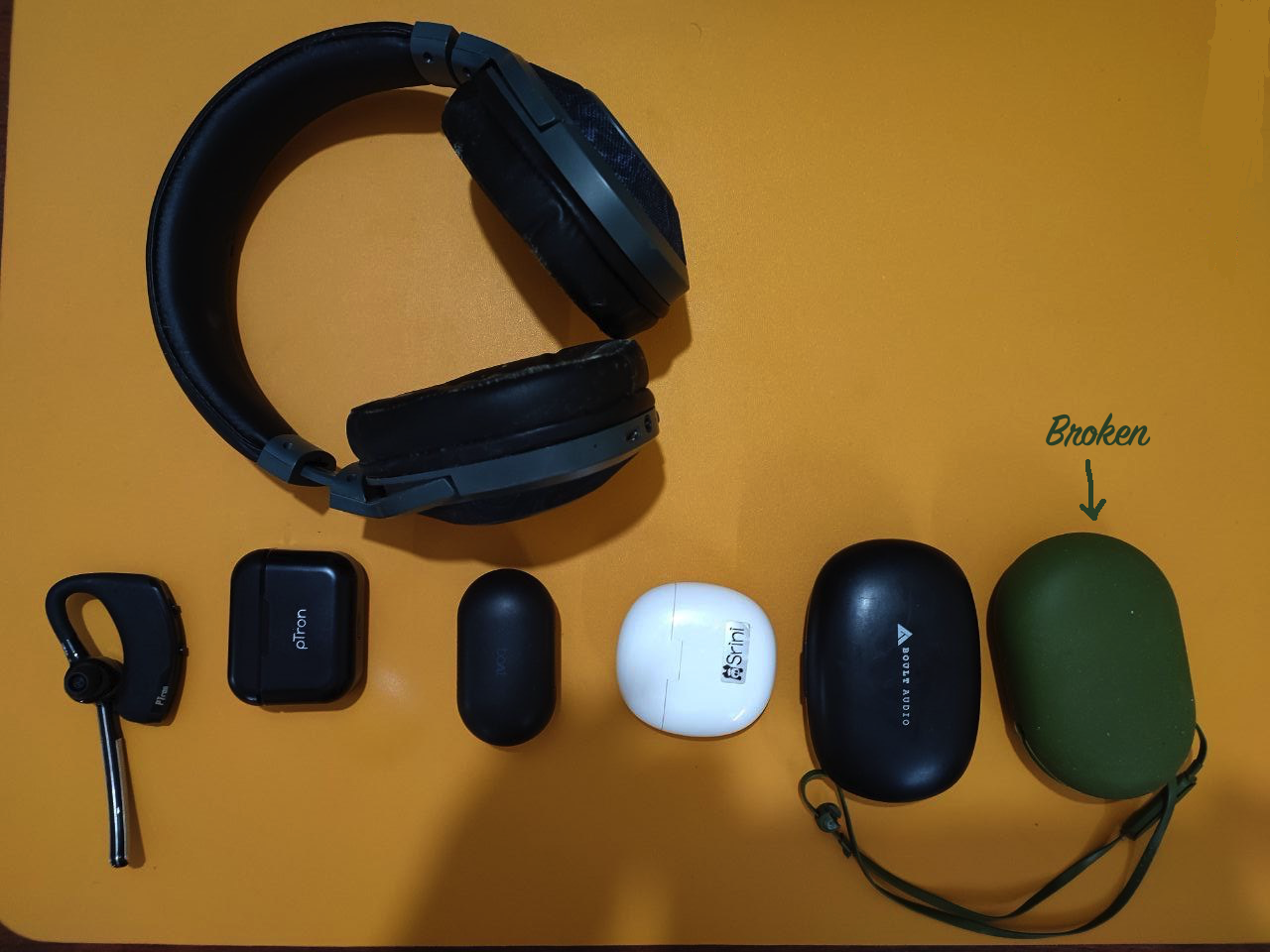
My set of bluetooth headsets
On the subject of gadgets, I have another related idiosyncrasy. I keep broken gadgets. Many times it is because I don't spend time checking for broken things. Other times, I have checked it, but I can't let go of it. An example is the green one in the above picture.
I probably have other shortcomings in this space and in my thinking. But these are at the top of my mind. Next let us move from thinking to actions.
Things I own: The actions I took or can take
Garbage overwhelms us and hence we need to take some action. Leo suggests first decluttering to reduce stuff, and then talks about how to maintain the rest.
Decluttering
For decluttering my setup at home or work, I need to do 2 things
1. Identify the essential.
2. Omit needless things
For doing this, contentment needs to take center-stage in our minds. We already discussed contentment (keeping it DRY!) and I know I have work to do there.
When we practically sit down to do this process of decluttering, we invariably will have some concerns. Leo calls it fears, and he lists them out:
1. Fear of needing it again
I have faced this fear whenever I have sat down to weed out things. Let me take an example: There is an HDMI port to HDMI port connector which I had used at some point for connecting my laptop to TV. I don't use it anymore, but it is still lying around. I could actually get rid of it, but I have the fear of needing it again.
One rule of thumb which Leo suggests here is to check if you have used it in the last 6 months. If you have not used it then you can throw it away. I could follow this rule and potentially throw it away. But if my fear persists then there is the next technique - "The maybe box".
The may be box is a place or container where you keep things which you may need at some point and are not willing to throw away. Ideally this is kept in a place which is away from your normal living area - the attic. I did use this hack, but there is a demerit here - I have not truly decluttered my life, but have just hidden it. Unless I have a regular cleaning routine I will soon have an overflowing attic!
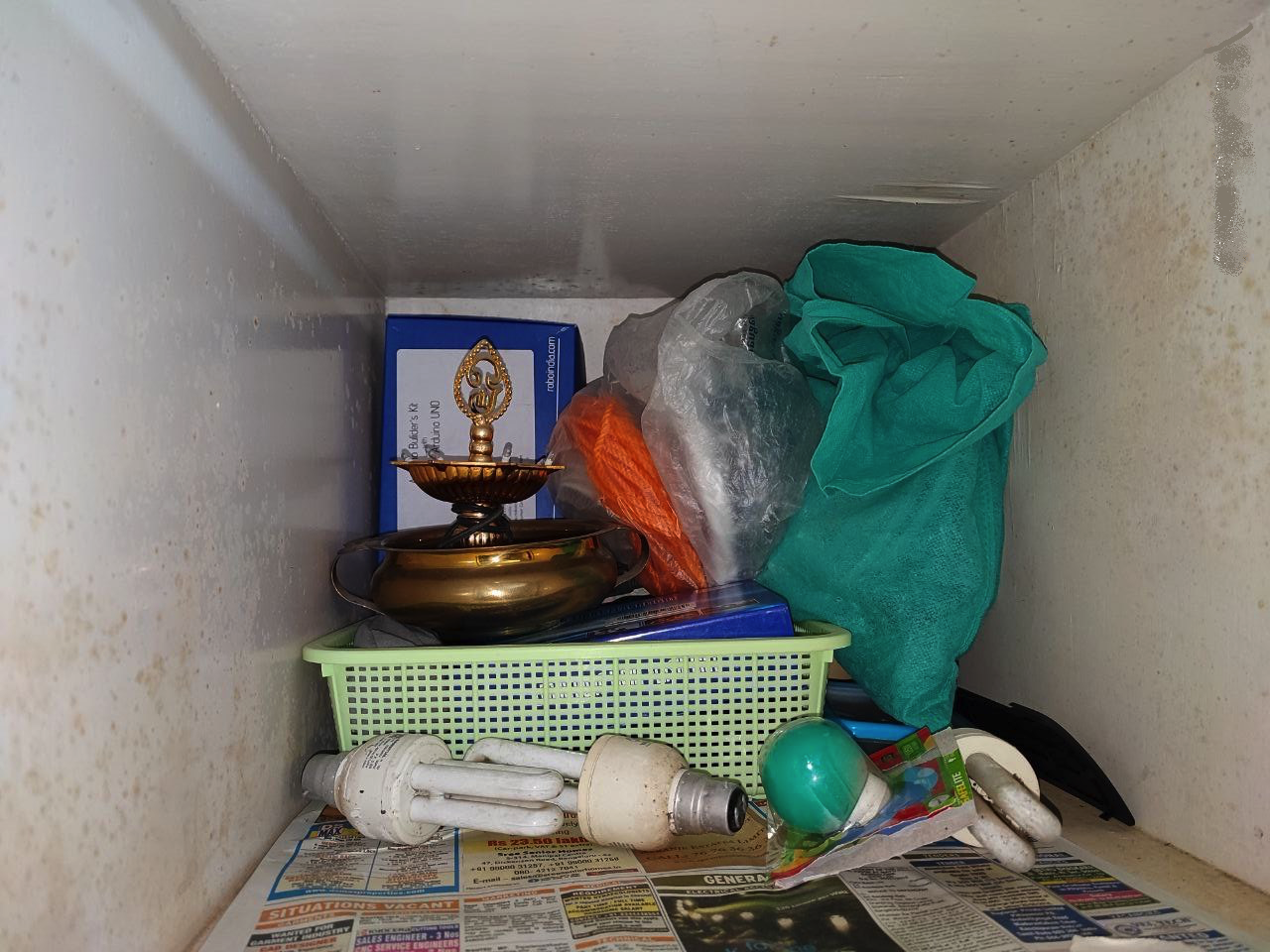
Part of my attic
To counter this risk, I do allocate time for attic cleaning, but I have to set up a monthly schedule to make it consistent.
Let us get to the next fear.
2. Reluctance to waste something valuable
I felt that this was a valid fear, in the beginning. My grandmother used to quote the below line to me in Tamil - சிறு துரும்பும் பல் குத்த உதவும் . It literally means, even a small piece might be useful as toothpick. So theoretically it is valid concern. But something else happens in practice.
We see something which is useful and keep it stored somewhere. It sits there collecting dust, eventually starts degrading and loses its value (stops working). While it may not be a good idea to throw a useful thing, it might be better to give it to somebody who can use it. But my childhood conditioning makes it very difficult for me to follow this. There are cases where I have practised this, but it is not always possible. One problem in practising the giving away part is that you don't find any suitable recipient for the same. In such cases I keep it around, only to find later that the item stopped working, hence no longer useful, and can only be thrown away. This is why this fear needs to be overcome.
Let us move to the last fear stated by Leo.
3. Not wanting to let go of sentimental things, because of emotional connection
I am not a very sentimental person, but there are occasions where I start seeing connection in things. It is primarily nostalgia. I still hang on to my eating plate even though it is a bit banged up because it was something which my father used.
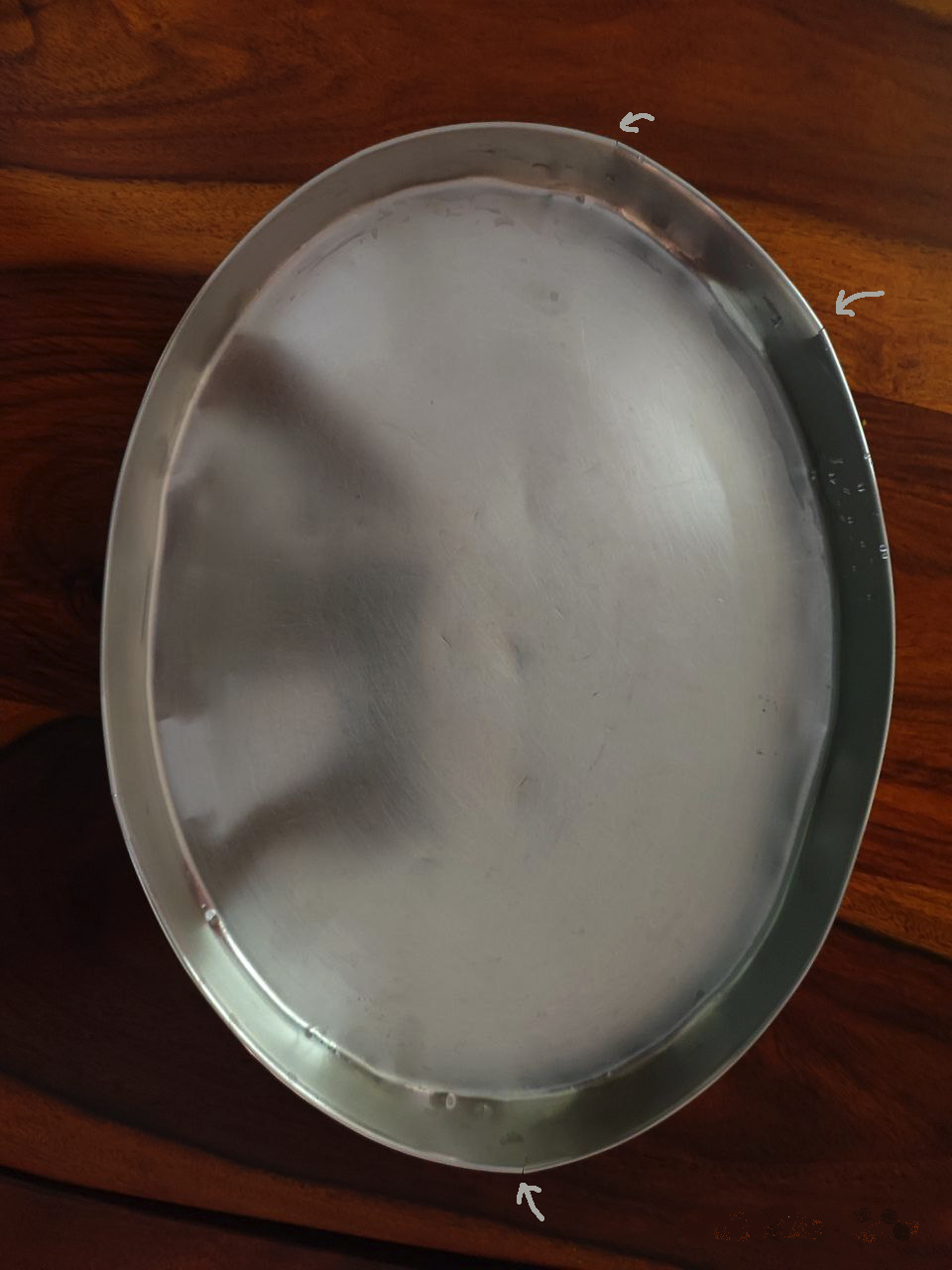
The plate I use to eat my food - broken in places and bent in others
As you can see the plate is very basic, but it is still usable. I don't have another plate to use and that is by design. At some point the plate might become unusable, and I have to figure out a way to let it go. Leo has a good idea for this. He says that we could take a photo for remembrance’s sake and then let go of the thing. I guess it could work. I may never look at the photo again, but at the moment when I have to part with the thing, it might offer me some kind of solace that I can look at its image later on. You could try it out and let me know if it works for you.
Keeping things well
Now that we have identified the essential and omitted the unnecessary things, what is the next step in the process of becoming a minimalist in terms of owning things.
The key idea which Leo mentions is to "find a place for everything you need". This is pretty good, but I feel the process has 3 steps:
- Determine the things you need (only): This was covered in the previous section (decluttering), but I am reiterating it here because if you have not done this then the next step does not work.
- Find a place for keeping those items: This is what Leo said (mentioned earlier), and it is a pretty clear. There is a controversial statement which Leo makes in this context - "Minimalising is the end of organizing". The act of finding a place to keep the things you need feels like organizing to me. Having said that the actual work does not stop there.
- Have the discipline to keep the items in its place all the time: For me this is a vital step if not the vital step. If I am not disciplined to do this, then the previous steps don't matter. I will pretty much be living in a cluttered place. Clearly Minimalism needs discipline and that is something we cannot forget.
There is one tip I want to throw in the context of the decluttering process based on my experience. Whenever I embarked on this process, if I had good energy levels and a stable emotional state, I made better choices on keeping only things that are really necessary and throwing the rest. The decluttering process involves decision-making and if you are not in the right state, you will slow this process down to make it laborious and useless.
Sustainability
One of the key themes which Leo talks prominently as a benefit of minimalism is "Sustainability". The world is stretched to its limits by the acts of humans like me. We really consume a lot of the resources available in the world. I don't have numbers to quote, but my own life progression tells me that I am using a lot of resources.
Leo says "Step lightly upon this world" and I think it is a mantra for me to remember and follow:

Sustainability: Photo by Noah Buscher on Unsplash
Creating macro changes to improve sustainability is difficult for me to do, but I can perform actions at my level. I can live with less. I have small house and a small car, but I can probably do better by reducing the other stuff I use. While there is the idea of using better materials (more earth friendly), I think there is an easier argument for using less.
As part of his actions to take, Leo says, "Make everything count". Making everything which I have chosen to use, must be used well without wastage. And what is not useful should be given away so that somebody else who needs it could use it. This can also help with improving sustainability in the world.
Closing thoughts
The best idea which Leo talks about in the book repeatedly is this:
Edit, edit. Minimalism isn't an end point. It's a constant process of editing, revisiting, editing some more.

Editing life: Photo by Suzy Hazelwood
The clear point conveyed here is that Minimalism is a journey. I need to start somewhere and keep going. Things may not be perfect in the beginning (and it probably will never be), but as I progress, I can keep editing and refining the process to improve myself and the surrounding lives. It is a process of continuous improvement. The key ingredient needed to make this happen is self-discipline.
I have started a routine of regularly decluttering my areas in the house. I have also found good places for the things I use. Now I need the discipline to make it stick.
I will write more about minimalism in terms of what I do at some point. In the meantime I want to listen to your thoughts on minimalism. Do you think the idea has any legs to stand? Are you already following it and if so what has been your experience? Please share as it will help me in my journey.
 Starting Point
Starting Point
Comments
comments powered by Disqus